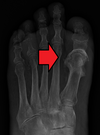Video:Pasteurellosis
| Pasteurellosis (Tutorial) | |
|---|---|
| Commons / NC | |
| Steps for video creation | |
| Step 1 | Preview my changes (10 sec) |
| Step 2 | Upload to Commons (10 min) |
Description
Pasteurellosis or Pasteurella infection[1] is an infection with a species of the bacterial genus Pasteurella,[2] which is found in humans and other animals.As the infection is usually transmitted into humans through animal bites, antibiotics usually are effective against the infection.[3]

Types
The several forms of the infection are as follows:skin disease, pneumonia disease and sepsis; other locations are possible, such as meningitis, and acute endocarditis, but are very rare.[4][5][3]

Presentation
The symptoms of Pasteurellosis can manifest as: swelling, erythema, tenderness, and purulent drainage.[3] Among the possible complications are: abscesses, and osteomyelitis.[3]

Cause
Pasteurella multocida is a Gram-negative, nonmotile, penicillin-sensitive coccobacillus of the family Pasteurellaceae, and the etiology of Pasteurellosis.[3]

Diagnosis
Diagnosis can be made with the isolation of Pasteurella multocida in a normally sterile site from (blood, pus, or cerebrospinal fluid).[6]

Differential diagnosis
The differential diagnosis of Pasteurellosis is as follows:Staphylococcus aureus, Rabies lyssavirus and Bartonella henselae.[3]

Management
Pasteurellosis is usually treated with high-dose penicillin if severe. Either tetracycline or chloramphenicol provides an alternative in beta-lactam-intolerant patients, however, it is most important to treat the wound.[6][3]

Epidemiology
In Australia, the incidence of Pasteurella spp. infections rose from 1 (point) 5 per 100 thousand population in 2000 to 11 (point) 4 per 100 thousand population in 2021.[7]

History
Pasteurella multocida was first found in 1878 in cholera-infected birds. However, it was not isolated until 1880, by Louis Pasteur, in whose honor Pasteurella is named.[8]

References
- ↑ "Pasteurellosis (Concept Id: C0030636) - MedGen - NCBI". www.ncbi.nlm.nih.gov. Archived from the original on 20 October 2023. Retrieved 28 September 2023.
- ↑ Kuhnert P; Christensen H, eds. (2008). Pasteurellaceae: Biology, Genomics and Molecular Aspects. www.horizonpress.com. Caister Academic Press. ISBN 978-1-904455-34-9. Archived from the original on 2016-08-13. Retrieved 2021-06-02.
- ↑ 3.0 3.1 3.2 3.3 3.4 3.5 3.6 Hasan, Jaan; Hug, Mark (2024). "Pasteurella Multocida". StatPearls. StatPearls Publishing.
- ↑ Colville, JOANN L.; Berryhill, DAVID L. (1 January 2007). "PASTEURELLOSIS". Handbook of Zoonoses. Mosby. pp. 127–129. ISBN 978-0-323-04478-3.
- ↑ Lloret, Albert; Egberink, Herman; Addie, Diane; Belák, Sándor; Boucraut-Baralon, Corine; Frymus, Tadeusz; Gruffydd-Jones, Tim; Hartmann, Katrin; Hosie, Margaret J; Lutz, Hans; Marsilio, Fulvio; Möstl, Karin; Pennisi, Maria Grazia; Radford, Alan D; Thiry, Etienne; Truyen, Uwe; Horzinek, Marian C (2013). "Pasteurella Multocida Infection in Cats" (PDF). Journal of Feline Medicine and Surgery. 15 (7): 570–572. doi:10.1177/1098612X13489215. ISSN 1098-612X. PMID 23813817. S2CID 10682140. Archived (PDF) from the original on 2017-09-22. Retrieved 2021-06-02.
- ↑ 6.0 6.1 Gautier-Lerestif, A.-L.; Desbordes, L.; Gaillot, O.; Avril, J.-L. (2003). "[Human pasteurellosis: diagnosis, treatment and precautions]". Annales De Biologie Clinique. 61 (1): 15–21. ISSN 0003-3898.
- ↑ Mahony, Michelle; Menouhos, Dimitrios; Hennessy, Jann; Baird, Robert W. (31 January 2023). "Spectrum of human Pasteurella species infections in tropical Australia". PLOS ONE. 18 (1): e0281164. doi:10.1371/journal.pone.0281164. ISSN 1932-6203.
- ↑ Pasteur, Louis (2011-05-13). "The Attenuation of the Causal Agent of Fowl Cholera". Archived from the original on 2021-11-19. Retrieved 2023-03-22.